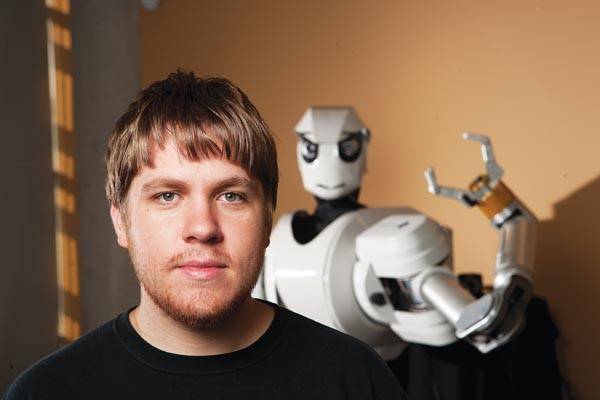Developments aim to mimic child growth

Taylor Bergquist, a soughmore in Computer Science stands in front of the main robot in Iowa State’s robotics lab. Taylor works with the robot under Alexander Stoychev.
September 8, 2009
A world of fantasy. A world of imagination. Although in the movies and on television, robots are not often thought of as a part of the real world.
For Alexander Stoytchev, robots are just another part of his everyday life.
Although Stoytchev, assistant professor in the department of electrical and computer engineering, was not able to work with robots until he started his graduate work, “It was always a fascination [he] had.”
“It probably dates back to the first time I saw Star Wars,” Stoytchev said. “Those robots were a big inspiration for me.”
His fascination with robots from Star Wars has become a part of his everyday life as he works with students, both undergraduate and graduate, in the Developmental Robotics Lab in Coover Hall to work on building and programming robots.
Stoytchev was recently interviewed for his work on the show “Brink,” which airs on the Science Channel.
“It was really a big honor because they focus on cutting-edge research,” Stoytchev said.
Although several months were needed to prepare for the big day, Stoytchev said that TV only gives you five minutes of fame, which is exactly what he got.
“We had to prepare for several months and the actual video shoot took 11 hours,” Stoytchev said. “They took probably seven hours of footage that was then compressed into five minutes.”
As Stoytchev continues toward the ultimate goal of building personal robots like the ones from Star Wars that first inspired him, he has to work on programming a robot to learn to do more than one task.
“The main goal of the lab is to figure out how to program robots so they can become more intelligent over time,” Stoytchev said. “The current model in robotics is to program a robot for a certain task. They do a great job at that, but ultimately that is really not what we want.”
To be successful, a personal robot will have to learn how to perform more than 1,000 tasks without being pre-programmed for every single one of the tasks in advance, Stoytchev said.
In order to accomplish this task, Stoytchev said the Developmental Robotics Lab must program the robots to learn as they undergo a development period, similar to that humans and animals experience, where they learn and develop skills over a period of time.
“We are not interested in creating robots that are like babies because that would not be very useful, but we would like to create robots that learn like babies,” Stoytchev said.
Besides all the work that Stoytchev and his students did to prepare for the show, Stoytchev said they also worked on building the lab’s upper-torso humanoid robot, which played a major part of role in the rededication ceremony for the new addition to Coover Hall last fall.
“When I got the call to participate in the ceremony, they gave me two months warning. I said ‘sure,’ but at that point the robot was not finished and was still in boxes,” Stoytchev said. “The ceremony was a big event, so failure was simply not an option.”
Although those two months were hectic, Stoytchev said they were able to finish the robot just in time to cut the ribbon for the re-dedication ceremony.
“We managed to finish building the robot two hours before the ceremony,” Stoytchev said. “My wife was eight months pregnant at the time, so that really added a lot of extra stress and pressure, but maybe that’s why we got it done.”
The work that occurs is his lab is not strictly by engineers. Stoytchev said that instead students from all areas of engineering, as well as human-computer interaction, computer science and the College of Design have all played a role in the development, building and programming of the robots.
“Robotics is inherently an interdisciplinary field,” Stoytchev said. “I have been impressed with all of [the students I have worked with].”
Two undergraduate students, Connor Schenck, junior in software engineering, and Taylor Bergquist, junior in pre-computer science, were able to begin working in the robotics lab during their freshman years through the ISU Honors Program. They began working with Stoytchev through the honors program’s Freshman Mentors Program, which pairs students with faculty members and involves them in research or a project.
Both students are continuing to work in the lab this year and are currently preparing for a robotics conference where they will present their first paper, which they wrote over the summer.
“Our paper just got accepted for a conference,” Bergquist said. “Basically the paper is about is how the robot [can learn] to recognize objects based on proprioception. We are working on preparing for this conference and are preparing to write another paper.”
Schenck said that Stoytchev has been great to work with because he has helped them get involved in his robotics lab.
“He’s a really nice guy,” Schenck said. “He’s been working a lot to get us involved. He has worked a lot to have us trained.”






